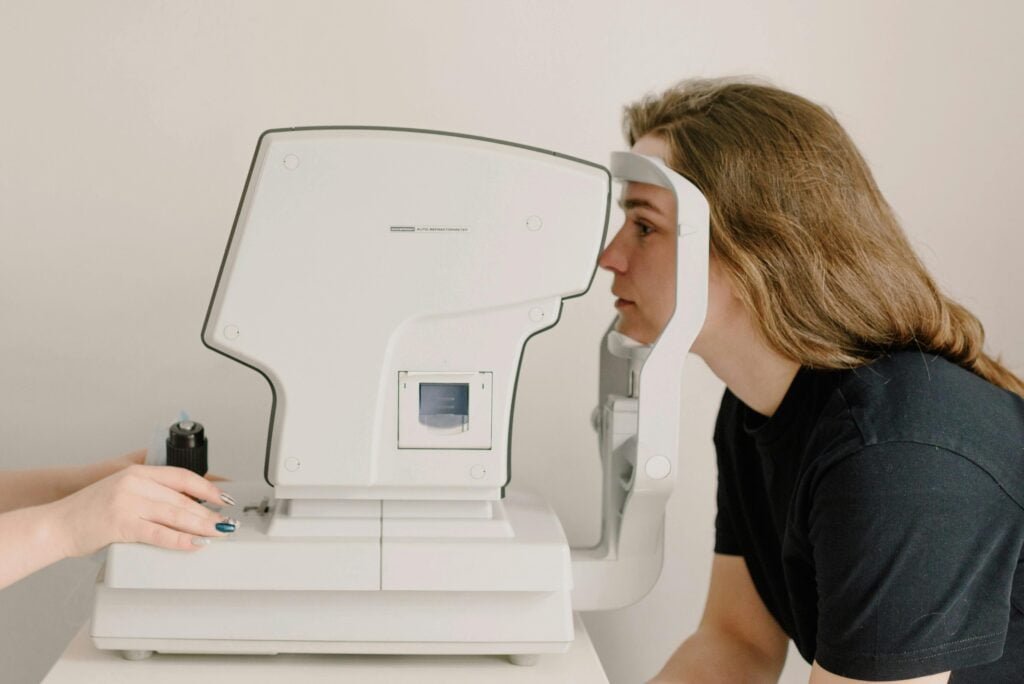Do you remember waking up with crusty, itchy eyelids? Like there is something stuck in your eyes? Blepharitis might be causing this issue. This condition causes quite a lot of inconvenience. But don’t worry! We are here to be your eye heroes. We will share everything about dealing with this pesky issue.
Table of Contents
What in the World is Blepharitis?
Blepharitis is a common condition that affects all of us at one or the other. The inflammation of the eye causes blepharitis. Then, this condition results in redness, swelling, and irritation in the edges of your eyelids.
You get blepharitis when there is an overgrowth of bacteria or the oil glands in your malfunction. Sometimes, both these issues can happen at the same time. Other skin conditions, such as dandruff and rosacea, can also irritate th eyelid. Sometimes, hormonal changes, allergies, and excessive oil production can result in blepharitis. You can also get the condition if you do not pay attention to your eye hygiene.
Blepharitis is a chronic condition. Not only does it last for a long time, but it will also keep coming back. These repeat visits are really frustrating for the affected person.
If you don’t get proper treatment, blepharitis will put you at risk of serious eye health issues. Some such eye issues are – stye, Chalazion, Corneal issues, chronic pink eye, and loss of eyelashes.
Who is at Risk of Blepharitis
Anyone can get blepharitis. It does not matter how old you are; you can get this inflammation of the eye. But, if you have dandruff or rosacea, then you are at a greater risk. People who wear contact lenses or have eye allergies are also more likely to develop blepharitis.
Symptoms of Blepharitis You Should Watch Out for
The intensity of blepharitis symptoms can vary from mildly irritating to disrupting daily activities. But, the inflammation will not cause serious issues to your vision. However, if you do not treat it, you might be at risk of developing styes or chalazions.
If you have blepharitis, your eyelids will become swollen and reddish. This will make the eyes look tired. In the mornings, you can see flaky skin or crusts at the base of your eyelashes. The inflammation causes itchy eyes. You will also feel a burning sensation and discomfort – like something is stuck in your eyes.
Your eyes will produce more tears as they try to flush out the irritants in your eyes. So, your eyes might be constantly watering. Blepharitis makes your eyes sensitive to bright lights. You will feel like squinting and closing your eyes more often. If the inflammation is severe, your vision can also become temporarily blurry. In severe cases, eyelashes will begin to thin and fall out.
The Two Troublemakers: Anterior and Posterior Blepharitis

There are two main types of blepharitis – anterior and posterior. Each of these conditions affects different parts of the eyelids. Both these conditions also have distinct symptoms, causes, adn treatment options. Here is a detailed look at the two types of blepharitis –
Anterior Blepharitis
Anterior (in front of) blepharitis affects the front of your eyelids. It causes inflammation and irritation at the edge of your eyelid. It causes persistent irritation at the edge of your eyelids. Anterior blepharitis is divided into two more sub-types –
The overgrowth of the Staphylococcus bacteria in your skin causes Staphylococcal Blepharitis. When there is an excessive growth of bacteria on your eyelids, it causes inflammation. The symptoms of Staphylococcal Blepharitis are – a sticky sensation on the eyelid, hard crusty scales at the base of eyelashes, along redness and swelling in the edges of the eye. The edges of the eye can feel sore when you touch them, And eyelashes will start falling.
The second type is the Seborrheic Blepharitis. This inflammation happens when your eyes produce excessive oils. This excess oil production leads to flaky and greasy scales on the eyelids. People with Seborrheic Blepharitis often develop yellowish and greasy flakes on the eyelids. Mild itching and burning sensations will also cause discomfort. You can also feel the redness and irritation in your eyes.
Posterior Blepharitis
Posterior (located behind or towards the back) blepharitis affects the inner part of your eyelid, the one that touches your eyeballs. There are also two types of posterior blepharitis –
Meibomian Gland Dysfunction (MGD) – There are tiny oil glands in your eyelids known as the meibomian glands. These are responsible for the production of the oily layer of the tear film. Sometimes, these glands cannot produce enough oil or produce poor-quality oil. This can cause dryness and irritation in the eyes. This dryness results in a gritty or dandy sensation and stinging in the eyes. You might have to blink to relieve the symptoms of blurred vision constantly. There will also be redness along the eyelids.
The second type is where the overgrowth of Demodex mites causes Demodex Blepharitis.
Demodex mites are tiny organisms that live in your hair follicles. An overgrowth of these mites can cause dandruff-like scales at the base of your eyelashes. There will be redness and inflammation along the eyelid margins. These mites will also cause intense itching and loss of eyelashes.
Diagnosis and Treatment of Blepharitis

The symptoms of blepharitis are often similar to those of conjunctivitis or dry eye syndrome. So, you may not be able to self-diagnose the inflammation. Or worse, you might end up misinterpreting the symptoms and not getting the right treatment in time. So, you must consult an eye doctor (opthalmologist) to get an accurate diagnosis.
The Diagnostic Process for Blepharitis
The eye doctor will begin the diagnosis of blepharitis with a detailed review of your medical history. You will have to share the symptoms, how they started, when they started, and how severe they are. It is also important to note any activities or factors that trigger or aggravate the symptoms. Information about your general health, specifically skin conditions such as rosacea or dermatitis, also helps in accurate diagnosis.
The doctor will use a slit-lamp microscope to get a detailed view of your eyes. This microscope is a magnifying device that will help the doctor to examine the eyelashes, eyelids, adn the surface of your eyes. Your doctor will identify the signs of inflammation, like crushing and flaking. The doctor can also observe the blockage of oil glands that might be causing blepharitis.
The slit-lamp examination helps your doctor determine if the blepharitis is on your eyelids or the inner edge of the eyelids.
Advanced Diagnostic Tools for Blepharitis
If the case more more complex, the doctor will need additional diagnostic tools for diagnosis. For instance, laboratory analysis of the sample crushing around your eye will have to be done. This test helps to identify the presence of bacteria or fungi that are causing blepharitis. Such a specific diagnosis helps the doctor to prescribe targeted and specific treatments. The doctor also has the option of using imaging devices to assess the tear film and ht meibomian glands.
Treatment Options for Blepharitis

Once your doctor confirms the diagnosis of blepharitis, the treatment will focus on the management of symptoms. Another priority is to prevent further complications. Blepharitis is a chronic condition. The symptoms also reappear frequently. So, long-term treatment is necessary along with eyelid hygiene practices.
Here are the main treatment and management options for the symptoms of blepharitis –
Warm Compress
Warm compress is the most simple and effective way of managing posterior blepharitis. The moist heat loosens the crusting and debris on the eyelids. So they are easier to remove. The heat of the warm compress also helps to unclog the meibomian glands. It softens the oils and improves the function of these glands.
For applying the warm compress, use a clean white piece of cloth. Soak the cloth in warm water. Wring it out to remove the excess water and place the folded cloth on your eyelids. Keep the cloth on your closed eyelids for five to ten minutes. You can use the warm compress twice a day for relief from symptoms of blepharitis.
Eyelid Scrubs
If the blepharitis is on the outside of the anterior, then eyelid hygiene is crucial for managing it.
You can get a specially formulated eyelid scrub for this purpose. Alternatively you can also make a DIY eyelid scrub. Dilute a dollop of baby shampoo in warm water to make this.
To use the eyelid scrub, clean your hands first. Soak a cotton swab or a clean washcloth in this eyelid scrub. Gently massage the base of your eyelashes with this cotton swab. Be gentle and do not cause further irritation. This cleaning process will help to loosen and remove the crusts on the eyelids. It will also remove the bacteria that is causing inflammation.
Medications
If the blepharitis is severe and disruptive, the doctor might prescribe medications. If your doctor detects a bacterial infection, then a prescription of topical antibiotics will be given. Your doctor might give you ntibiotic ointments to apply on the eyelids or eye drops. If rosacea is causing chronic blepharitis, then oral antibiotics will help in management, These antibiotics help to target the bacteria and also reduce swelling and redness.
Anti-inflammatory medications such as steroid-based eye drops or ointments are useful for addressing severe inflammations. However, these are best suited for short-term use. The potential side effects of the steroids make them dangerous for long-term use. If the cause of blepharitis is a fungal or viral infection, then antifungal and antiviral medications are useful for treatment.
Artificial Tears or Lubricating Eye Drops
Blepharitis often results in dry eye syndrome due to inadequate tear production. Artificial tears or lubricating eye drops help to relieve the symptoms of dry eyes, such as irritation and grittiness. There are many artificial tear products available over the counter. But, your doctor can prescribe specific formulations depending on teh cause of your inflammation and the severity.
Lifestyle Adjustments
Blepharitis is a chronic and recurring condition. So, along with medication, lifestyle changes are also necessary to manage the symptoms. A healthy lifestyle will control the symptoms and reduce the severity of the flare-ups. Eating a nutritious diet rich in omega-3 fatty acids improves the function of meimbomian glands. Adding foods like fish oil and flaxseed helps to manage the inflammation.
If you have conditions such as rosacea, then stress will aggravate or trigger blepharitis. So, practising meditation and deep breathing for stress management will help to manage the inflammation also. Managing skin conditions such as dandruff and dermatitis will also help to reduce your risk of blepharitis. Proactive care with eyelid hygiene practices is the key to managing blepharitis. If you are using contact lenses, switching to glasses also helps to minimize the irritation.
Proper Makeup Hygiene to Preventing Inflammation
Your eye makeup often contains harsh chemicals that can cause irritation and inflammation in the eyelids. If you have blepharitis, switch to hypoallergenic or mineral-based makeup to protect your eyes. No matter what makeup you use, always remove it completely before sleep. You can use a gentle, oil-free remover for this purpose.
Replace your makeup every three to four months. This will protect you against bacterial growth. Also, avoid putting makeup on the inner edges of your eyelids.
Blepharitis in Children: A Special Note for Parents

Blepharitis is not just a grown-up eye problem. It can affect the kids, too. So, parents should know about the signs of blepharitis in children and the treatment options. If you can recognize the symptoms early, you will save your child from a lot of discomfort. Early diagnosis also makes the management of symptoms easy.
Recognizing Symptoms in Children
The kids may not notice the discomfort of inflammation in the early stages. They also may not be able to communicate their discomfort to you. So, you should keep an eye on certain signs and behaviors that indicate inflammation of the eyelid.
The intense itching and burning sensation of blepharitis can make the kids constantly rub their eyes. Your child may wake up with crusty and flaky eyes in the morning. This crusting can even make the eyelashes stick together. Red and swollen eyes are an obvious indication of inflammation in the eye. Complaints of pain or grittiness in the eyes could also point towards eyelid inflammation. If the child has watery and teary eyes, then it is a cause for concern.
Understand the Causes
The causes of blepharitis vary slightly between the adults and the children. Allergic reactions to pollen, pet dander, and dust can trigger inflammation in the kid’s eyes. This inflammation can develop into blepharitis. Suppose the child has skin conditions such as eczema or dermatitis. In that case, they are at a higher risk of developing inflammation in the eyelids.
Kids also may not always keep up with their eye-hygiene routines. So, they are at risk of bacterial build-ups on the eyelids.
Treating Blepharitis in Children
The treatment of blepharitis in children is similar to that of adults. The focus is on easing the symptoms and making the child comfortable. You can help your child apply a warm compress on the eyelids. You can help the child rest during this time by reading a story to them or playing their favorite music. If you join your child during the eyelid cleaning routine, they will not skip it. You can try making faces in the mirrors to make it fun for them. Let them do the gentle cleansing under your close supervision.
Pediatric eye doctors also prescribe medications like antibiotic ointments. Your child might also need additional treatments for underlying skin conditions. Even if the symptoms improve, complete the course of medications.
Blepharitis – Myth Burtsting
Blepharitis is not contagious like the pink eye. You can not catch it from someone else. So, if your loved one has inflammation, you can attend to them without the risk. People of any age can get blepharitis, including young children. The inflammation will not be resolved on its own. If you do not treat it, you will be at risk of many serious eye health issues. It is also a chronic condition that needs regular management. Blepharitis does not automatically mean poor eye hygiene.
If you address the symptoms with proper care and medical treatment, blepharitis should not cause you much trouble. The itchy, crusty eyelids will soon go back to their happy, healthy selves in no time.



